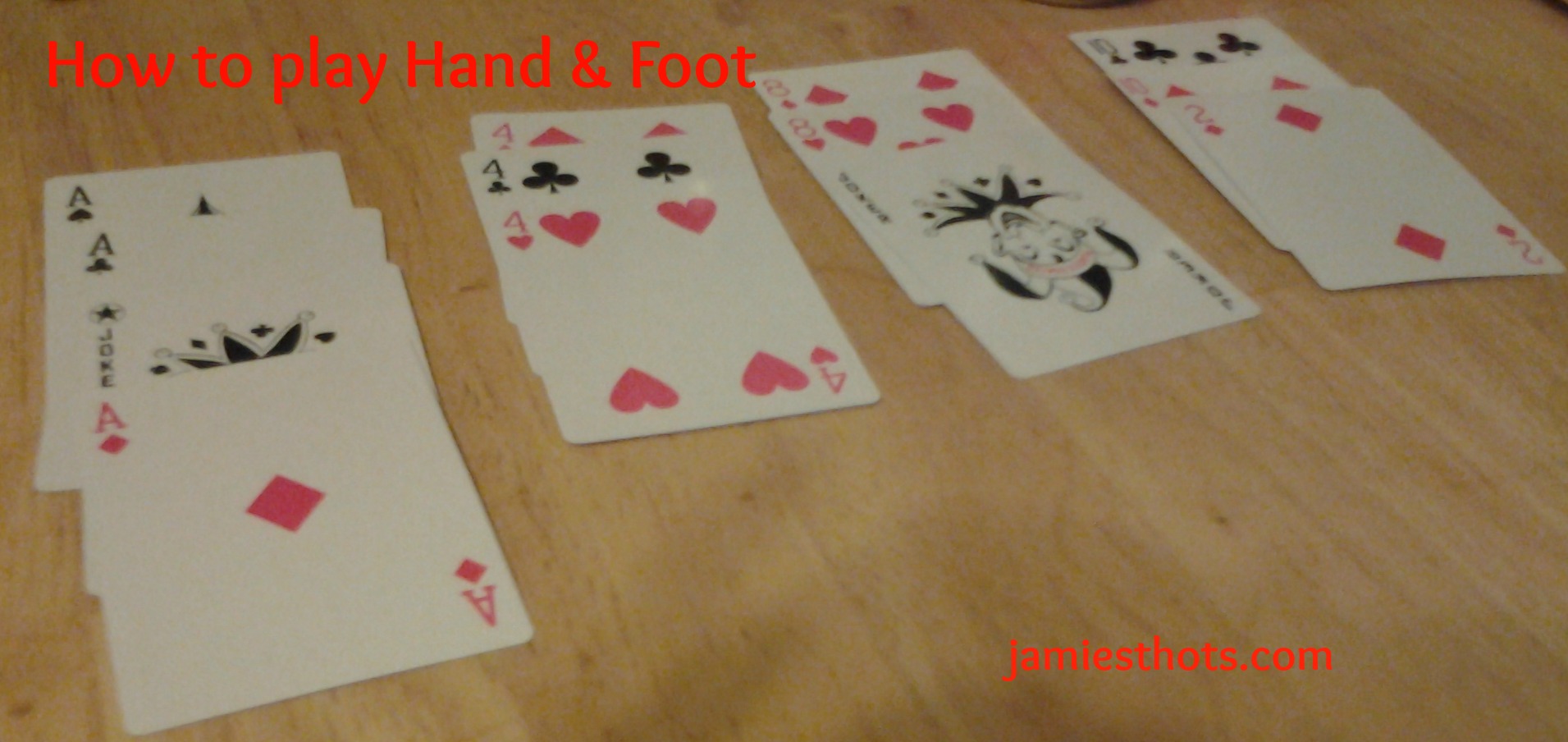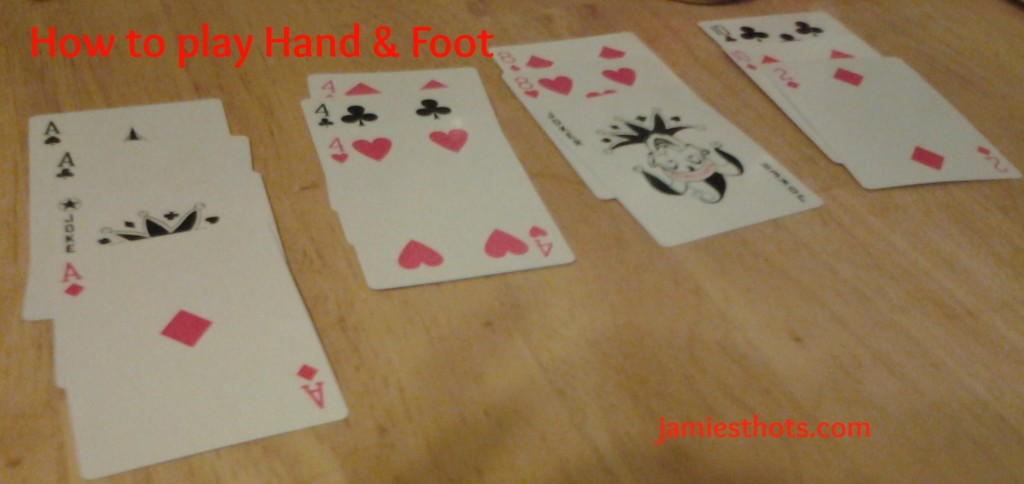I’m not much of a card player because most of the time it seems like card games require some kind of strategy. When I play games, I think it’s more fun to just relax.
One exception is a game called Hand & Foot, a game my family has played for years. Though there are many versions of the rules, I thought I’d share the rules I prefer to play by here. By sharing these, I’m exposing readers to a fantastically fun family game, but also establishing “house rules” on the Internet. (At least one family member declares his rules are the real rules because he found them on the Internet. That means my rules can now be the real rules…HA!)
You need:
- A deck of cards per player plus one. (Example: If you have four players, you need five decks.) Combine and shuffle all the decks of cards together
- I would recommend an auto-shuffler
- Writing instrument and paper to keep score
Objective:
The person with the most points at the end wins…profound, I know. A person wins a round by collecting “books” of 7 cards that are of the same number. To “go out” (win the round), a player must collect a “clean” and a “dirty” book. A clean is one that is made up entirely of 7 cards with the same number (can be of any suite). A dirty is a book made up of 7 cards combining wild cards and the numbered cards (must have at least one more numbered card than wild cards).
How to play Hand & Foot:
- Separate the cards into two piles, and each player picks a small group of cards off the top of one of the larger piles. These “piles” are stacked neatly and usually divided into two just to make them easier to handle.
- Each player counts their small pile into two stacks of 11. If a player gets exactly 22 cards, they get a bonus 100 points. Any remaining cards are added back onto draw pile.
- The first stack of 11 becomes the player’s “hand”.
- The second pile, or “foot”, is placed to the player’s side for later play.
- To determine who starts the game, each player randomly picks a card from the middle of the draw pile and whoever has the highest value card (Aces are high) gets to start first. In subsequent rounds, the person to start the round is the next player in a clockwise motion.
- When a player has a turn, he or she must pick two cards from the two draw piles (either one card from each pile or two cards from one pile) and when they are done playing that round, they must discard a card into the discard pile.
- A player starts to create the books by starting with a set of three: Either all three of the same number or 2 of one number and a wild card. (Example: 3 Queens or 2 Queens and a wild card.) To “lay down” (start their first book), the point values of the first three cards must equal a “meld.” The first book usually requires that the player meld 50 points before laying down (more on this later). Subsequent books created must start with three cards of any total value.
- The players take their turns, each drawing two cards and then playing what cards in their books that they can before discarding one hand.
- When the first hand runs out, the player can then “get into their foot” to play those cards as well. If the hand runs out before the player discards, the player must declare “I’m just playing my foot” or “I’m still playing”…or something to that effect. They can then seamlessly continue playing until they have no other options to lay a card down and then must discard a single card.
- When a book of seven is achieved, the player places them in a single stack with the top card being a red card for a clean and a black card for a dirty. Again, to “go out” a player must get a clean and a dirty and be completely out of cards to go out. To go out, a player must discard a final card, not simply run out of cards. Players can accumulate more than one clean and one dirty through the course of the round.
- When a player goes out, thus signifying the end of the round, all the players must count their point totals for the round. The score keeper records the “meld count” first, meaning how many points in completed books each player has earned. The players then get their second point count by counting the point total from each played card’s value. This includes individual cards in the completed books as well as cards that have already been laid down into a partial book. Any card left in the player’s hand counts against the net total for that round.
- To start a new round, the same 22 cards must be counted for each player and the process starts over again with the first player in the round being the person next to the first player from the first round in a clockwise order (to the first player’s left).
Counting points in Hand & Foot:
- Each card and each book has its own assigned value.
- For the most part, cards numbered 3-7 are worth five points (see below for exception)
- Cards numbered 8-10, J, Q and K all count 10 each
- Jokers and Deuces (2s) count as wild cards and are 50 points each.
- Aces count as 20.
- Major exception: All red 3s count as 300 points (yes, three hundred) against the player, even if played. This would mean that red 3s are of top priority to get out of the hand and are to never be played.
- A player that “goes out” in a round earns an additional 100 points for going out. People consider it worth more points to hold off on going out and attempt to earn more books.
- Clean books are worth 500 points.
- Dirty books are worth 300 points.
A few more playing points:
- Smith house rules say that a player cannot pick up the discard from the previous player’s discarded card. This allows the next player to go ahead and draw their two cards while the player before them is still playing their hand, making the game move faster.
- Once a book has been established, if a player draws a card that fits that book, they can add that card to the book, thus creating a book of more than seven cards. A player cannot change a dirty to a clean if seven cards of the same number are eventually achieved. Some players believe that a new book must be started when the same numbers are drawn.
- There are different ways to change the meld required to lay down an initial book on a round. A way to make the game shorter is to decide there will be four rounds with the first round requiring a lay down meld of 50, 90 for round 2; 120 for round 3; and 150 for round 4.
- You can also play to 10,000 points, meaning you play rounds until a player earns 10,000 points to win the entire game. This can take a very long time! If this method is used, then the melds go by total points. Up to 1250 points a player must meld 50. After that, each time a player achieves another 1250 points, the meld requirement increases from 50 to 90 to 120 to 150.
To read other rule variations, check out this site.



Sound similar to canasta, yet with a uniqueness of its own. I think I’ll try this sometime.
I’ve never played Canasta but all the sites say this game is similar!
Thank you for the info, i am starting a new activity in our senior park. a great help,
Shirl
I’m also a big fan of Hand&Foot. Our family actually has Hand&Foot tournaments. Best Card game ever!
We love it so much, I wrote a simple android app to help with the game scoring. Best of all, it’s free.
https://play.google.com/store/apps/details?id=com.chirpmetrix.handandfoot
John
The player had four cards in her hand and said she wanted to go out. Two cards would play on two books but she had 2 wild cards and wanted to play them also on the remaining two books. I told her she couldn’t do that and have to wait her turn agasin. We weren’t sure about this? CV in Arlington
A person must discard to go out.